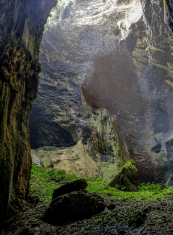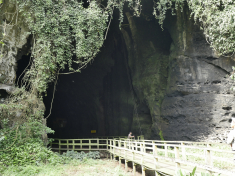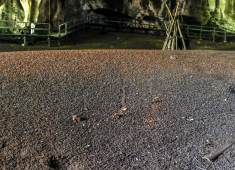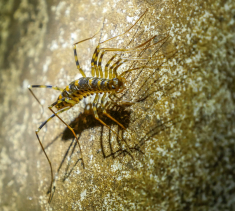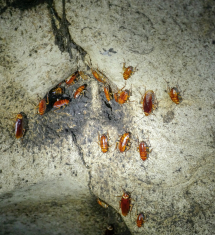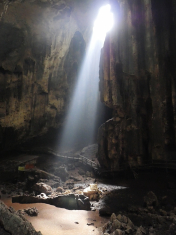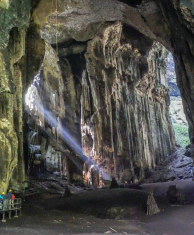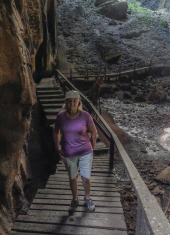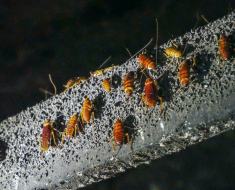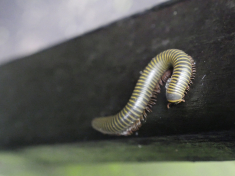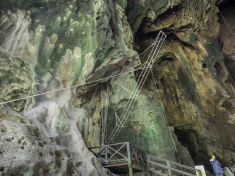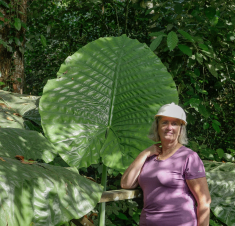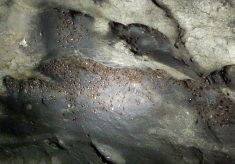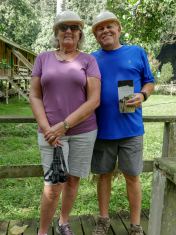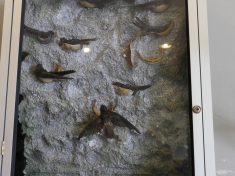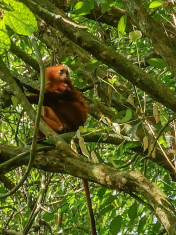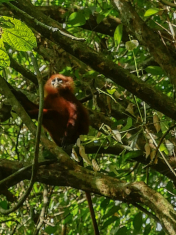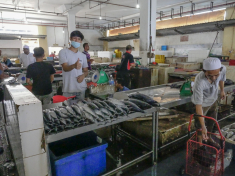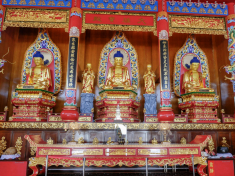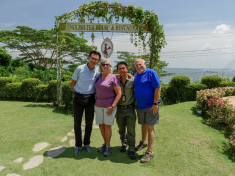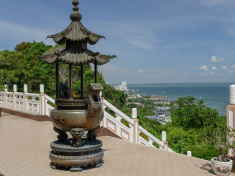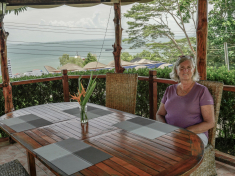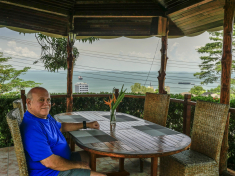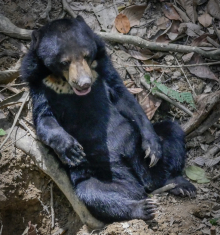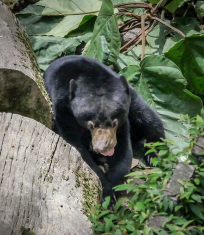Its black fur is hard to spot from the high walkway, but when you see the shiny, golden, crescent-shaped fur collar around its neck, you realize you’ve spotted the tiniest bear in the world – a Bornean Sun Bear. Every individual bear has a unique fur collar like us humans have our fingerprints, and that’s how their keepers will know who’s who. The Bornean Sun Bear Conservation Center is in Spielok, where 44 rescued ex-captive or orphaned sun bears live.
Sun bears look incredibly cute and cuddly, especially because they have a tendency to hang their long, pink, and thin tongue out of their mouth most of the time. Sun bears are also known as a “honey bear” because of their particular appetite for honey or a “dog bear” because of their small size (smaller than a St Bernard). Sun bears are native to South-East Asia and are the smallest of the world’s eight bear species. They have black, shiny pelts and extremely long, slender claws. They are critically endangered, since so much of their habitat has been destroyed by the palm oil plantations. Plantation land clearing crews, find them and take them home, thinking they have a new pet — that is until the claws grow so sharp!
We had our last lunch at this lovely English Tea House, and realized that today would be the last time we would see our trusty guide, Mr. Man and our wonderful driver Mr. Moon. They have worked so hard to share a land they obviously love with us. And we are grateful to them. After lunch is the Sandakan town visit.
Just outside of town we find the Puu Jih Shih (Syh) Temple. Built in 1987, the beautifully ornate temple, immaculately cared for, has some wonderful views over the bay and fishing village below. We stepped into the temple – and enjoyed the extravagant decor with the blaze of red and gold, writhing dragons and golden Buddha statues. Puh Jih Shih Temple was featured on The Amazing Race 4 episode 10.
We stopped at a fishing village in outside Sandakan, houses here are mainly wooden and built on stilts in the sea, fronting the coastline. As we took a walk along the wooden boardwalk we see all the comforts of home, electricity, air conditioning and cable TV, we asked where the sewer lines were and learned that residents here basically dump their waste into the sea bed. There are many houses with well-tended verandas, the outdoor space for those living here. An interesting insight of the traditional way of life of the local people who have been living here for several generations.
People love markets for so many reasons — top reason is the experience: seeing people, opportunities for impromptu conversations, the unexpected sensory delights. This is what draws people back, again and again, to their favorite markets. This is real life. Where grocery shopping is done, where fresh fish are brought directly from the sea and clothing is bought, and families enjoy meals. It is the right place to see the real people of the place you are visiting, no matter where in the world you find yourself.
Sir David Attenborough aired his documentary series, “Conquest of the Skies”, featuring Borneo’s Gomantong cave, home to a variety of bat species. We went to see Gomantong cave and its batty inhabitants. I think we’re in deep guano!
Gomantong Cave is home to over a million bats. These bats share the cave with birds called swiftlets, whose nests are prized as an ingredient in bird’s nest soup. The cave is also home to billions of cockroaches and beetles, who live in the massive piles of guano the bats produce. The entire cave is a massive ecosystem that relies on its populations of bats and birds.
Arriving at the cave entrance, I was instantly breath-taken by mysteriously beautiful view of the cave, a large shaft of light streaming down. Inside the cave, we discovered the base of a steep rock pile left by a collapse in the cave roof. Above the rocks, daylight streamed through a large hole some 200 feet above the floor – and at our feet, an enormous, chocolate-brown cone of guano rose. The mounds looked alive, the strange dank, ammonia smell in the air was laced with a faint familiar stench. As the beam of our torches picked up the movement, immediately the stench came to light (sic). It was a seething blanket of cockroaches! Cave cockroaches! The cave is alive! Cockroaches, cave centipedes, millipedes, beetles, worms, spiders – a variety of bugs and a closed ecosystem.
Native bats take shelter in the cave during the day, whereas the swiftlets rest in the night. This creates a 24-hour feeding ground for dung beetles and cockroaches, which the snakes subsequently feed on.
The edible-nest swiftlet, build nests on the cave walls that are purely from their saliva. The white nests are small but valuable. Per kg, of the quality found, here will cost approximately USD1,000 – USD2,000 in the open market. The swiftlets build their nest at night, after a day out searching for food. The new nest takes about 30 to 35 days to complete and once that’s done, and the mother lays a maximum of 2 eggs which she broods for 1 month. When the fledglings are old enough to leave the nest, the harvesting season begins. The harvesters must make sure that the nests are collected only after they are abandoned by the young swiftlets.
We emerged from the limestone cliff to a small cluster of timber long-houses used by those who collect the nests. Inside the cave, ladders of twined rattan vine and hardwood rungs hung from the ceiling at dizzying heights. The nest collectors will dangle from these ladders like flies in a spider web. Another type of ladder, made from a hardened bamboo poles, pivots around the cave to reach the highest nests.
The journey from the cave back to the entrance takes approximately 10 minutes. Along the boardwalk, surrounded by verdant foliage (elephant ears, the largest leaves I have ever seen) and cool FRESH air, we spotted the red leaf monkey! We hung around long enough to see them move from the sunny side of the boardwalk to the shaded side.
Sandakan is a magical place!


